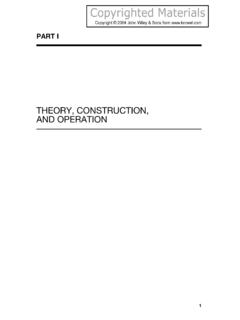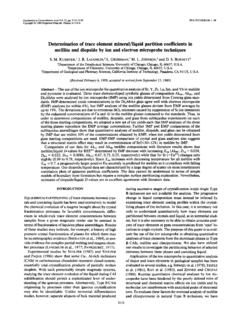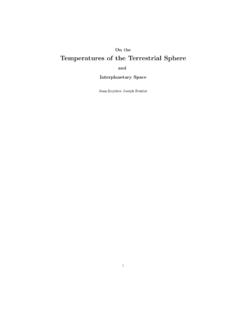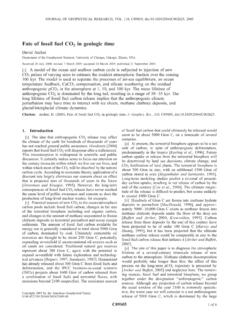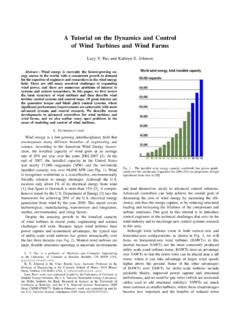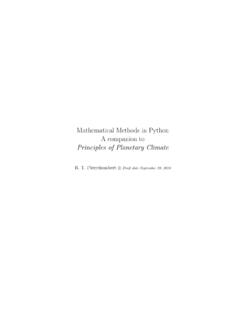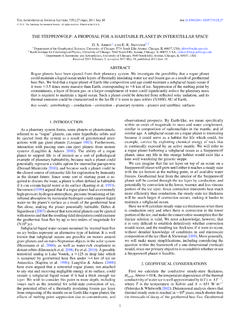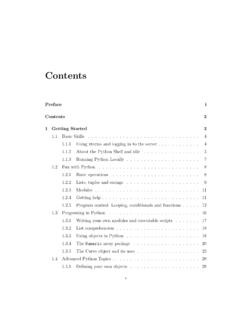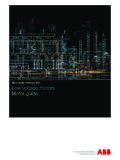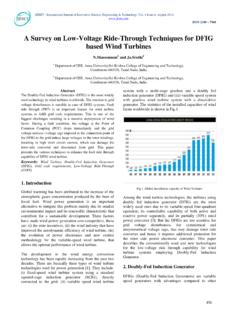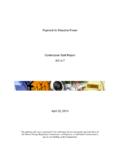Transcription of EJ Moyer, U. Chicago April 29, 2010
1 Basics on electric motorsEJ Moyer, U. ChicagoApril 29, 2010 BackgroundElectric motors are essentially inverse generators : a current through coils ofwire causes some mechanical device to rotate. The core principle underlyingmotors is electromagnetic induction. By Ampere s law, the current inducesa magnetic field, which can interact with another magnetic field to producea force, and that force can cause mechanical motion. A motor is basicallya generator run backwards (using current to produce motion rather thanmotion to produce current), and in fact the modern era of practical motorswas initiated by accident when one DC generator was accidentally connectedto another in 1873, producing motion and leading Zenobe Gramme to real-ize that his generators could also be used as motors. The first AC motors(synchronous and then induction) were invented by Tesla in the motors are estimated to now consume over 25% electricityuse (though some estimates are even higher, to up to 50%, and over 20%of total primary energy).
2 While large electric motors can be extremelyefficient at converting electrical energy to kinetic energy ( >90%), thoseefficiencies are only achieved when motors are well-matched to their efficiencies in normal usage practice in the are substantially sub-optimal (motors are oversized for the loads they drive). Small electric motorsare also inherently less efficient (more like 50%). Motor design and, evenmore importantly, motor choice and use practices are an important area ofpotential energy reading is a (very brief) introduction to four most basic types ofelectric motors: Brushed DC Brushless DC Synchronous AC Induction(Remember, anything you plug directly into the wall is AC; anything yourun directly off a battery must be DC).Like generators , electric motors consist of a stator and a rotor and thethree ingredients: electric current, magnetic fields, and something basic rule of thumb is that in an AC motor, as in an AC generator usedfor industrial power production, the magnet is on the rotor and the current1flows in the stator.
3 In most DC motors, the magnet is in the stator and thecurrent is flowing in the rotor; hence the need for specifications usually involve several quantities: the voltage (orrange of voltages, for DC motors) that the motor can be run at, the rotorspeed (or range of speeds), the electrical power drawn by the motor (oftengiven in horsepower rather than Watts), and finally, the torque or effectiveturning force of the motor (discussed further below). Modern motors span awide range of all these quantities. In particular motors can span 8 orders ofmagnitude in power consumed. Tiny DC motors of the kind used in toys area few Watts in power; big AC hydro generators that are also run backwardas motors to pump water can be over 100 Megawatts. (For more comparisonof motors in daily life: the motor in a household power tool is often 1/4 hp(<200 W) (though they take much more power when starting up); a ceilingor floor fan is<100 W; the compressor in an air conditioner is>1000 W).
4 Torque is a useful concept when describing forces that produce rotationrather than linear motion - it s a measure of the ability of a device to turnsomething. Everyone has an instinctive idea of the power of a lever: if youtry to move something by prying with lever (think of turning a stubborn boltwith a long wrench), you can exert more turning force with a longer leverthan with a short one. Torque (we ll call itT) is that turning force . Inthis definition and the math that follows, the bold-face means that quantitieshave a direction as well as a (optional)The definition of torque isT=r Fwhereris the lever arm andFis the force, and the cross product means thatyou consider only the component of force that is perpendicular to your leverarm, F Newton s lawF=mathen has an analogous form for this tuining force as:T=I where I is the moment of inertia (a measure of how difficult a body isto rotate) and is the rate of change of angular velocity (d dt, where is2the angular velocity).
5 Note that although torque desribes an ability to pushsomething around, its units are force times distance, or plain(er) English, torque is a measure of how much ability a devicehas to rotate a load. Because the function of a motor is to rotate things,that s the ability you care about. In particular, in motors one often wants toknow the torque-speed curve. How does the rate at which a motor rotatesrelate to its ability to turn a load? Some motor have better turning abilityat high speeds, other at low speeds. Which you choose depends on what jobyou want the motor to do. If the motor torque is too low, it won t be able todo the job. Alternately, as discussed above, if your motor is more powerful(higher torque) than you need for a particular job, it will do the job but willhave unnecessary energy inefficiency. (It will waste energy as heating ratherthan converting it to work).
6 DC motorsBrushed DC motorsThe simplest (and cheapest) DC motor is the brushed DC motor. A brushedDC motor is like the simple loop generators we ve seen in cartoons (or theJensen generator used with the steam engine), only run backwards: themagnet is stationary and the DC-current-carrying coil (or coils), connectedto a shaft, rotates through the fixed magnetic field. Loop generators we veseen use slip rings to make electrical contact between fixed current-carryingwires and the rotor. But remember, in the simple loop generators , steadyrotation in one direction with a slip ring produced alternating current. And amotor is the converse of a generator. So if you drove the slip-ringed generatoras a motor withalternatingcurrent, you could get steady rotation. If drive itwithdirect current, though, the loop would just move to a place where forcewas zero and would stay there.
7 To keep the loop moving and produce rotationin one direction requires not slip rings but some kind of commutator thatessentially switches the diretion of the current, putting it first on one side ofthe loop and then on the other, mimicking alternating current. Only if youmanage to continue to kick the loop around will it keep simplest commutator is a split ring that makes contact with twoseparate brushes. In the simple AC loop generator, the rotating and fixedconductors are connected with two slip rings, each of which maintains a3 Figure 1: DC motor with rotatingloop, brushes and split-ring commuta-tor (Encyclopedia Brittanica)Figure 2:Slip rings for AC gen-erators/motor (bottom) and splitringsforDCgeneration/motors(top). connection between one end of the rotating loop and a fixed split ring commutators joins both ends of the loop to fixed wires, andevery half-rotation, the contacts are a generator, the simple split ring commutator on a single loop gener-ator would produce a voltage (and current) around the loop that is a singlerectified sine wave, varying between zero and maximum every quarter rev-olution.
8 In a DC motor with a simple split ring commutator, the torqueprovide by the motor is similarly irregular, varying from zero to maximumevery quarter revolution. The motor doesn t provide steady even rotationalforce but a jerky force, wich is obviously not ideal for industrial is termed torque ripple. To minimize torque ripple, DC motors usethe same strategies that DC generators use to minimize voltage ripple: in-creasing the number of windings on the rotor or magnetic poles on the stator.(The windings on the rotor are also called the armature ). By producingmany out-of-sync rectified sine waves superimposed on each other, addingwindings or poles begins to approximate a constant DC motors seem like a relatively practical solution, but there aredrawbacks. The brushes themselves wear out fairly fast, and it is not wiseto put big amounts of current through brushes that make sliding contacts,as they will spark as contacts are made and then broken.
9 If the rotor turnstoo quickly, the sparking can damage or destroy the commutator. Designing4 Figure 3: Small commercial DC mo-tor w/ permanent magnet, cut awayto show insidesFigure 4: Reduction of torque ripplein DC motors by adding multiple rec-tified sine brushed DC motor involves tradeoffs between power, speed, and obvious application for brushed DC motors is in the cheapest ofall motors, small lightweight low-power essentially disposable motors thatpower cheap battery powered devices ( toys). These cost a few dollars atmost and wear out relatively quickly but are then just thrown away. Thesesimple motors use permanent magnets in the stator instead of magnets are heavier but simpler and cheaper. They also haverelatively simple armatures and so significant torque motors are now just cheap options for unimportant uses, behavior has some very appealing characteristics that make DC motorsversatile and desirable for many uses, more so than AC motors.
10 First, therotation speed of a DC motor is directly tied to its supply voltage, whichcan itself be varied within some range to produce variable motor speed. DCmotors can also be designed to rotate at any desired speed for a fixed supplyvoltage, unlike AC motors, which (as discussed in the problem set and below)are constrained to only certain rotation speeds. Secondly, DC motors have5strong torque at low speeds (again unlike AC motors, where torque goes tozero as the motor stops). The bigger the load on a DC motor, the slowerit will go, but the bigger its torque will also be. If you suddenly increasethe load on DC motor ( attach something difficult to push to its rotor),the motor will slow down but will eventually reach some equilibrium whereits torque has increased sufficiently to continue pushing the load around. Incontrast, an AC motor, if overloaded, will just stop.
